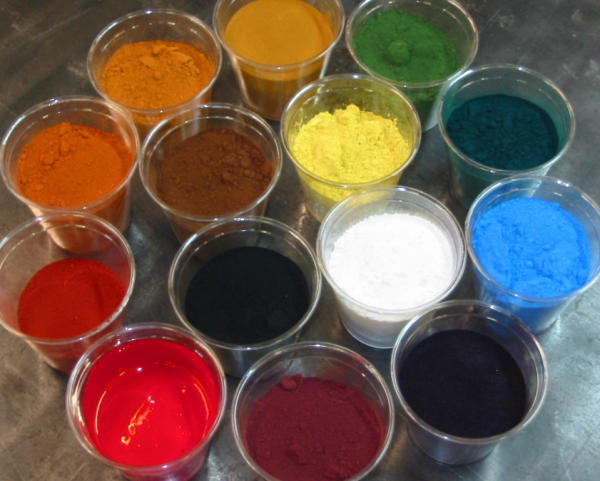Concrete can be colored in a variety of ways, including using acid staining, dyes, colored aggregates, cement and integral pigments. This article explains the various types on integral pigments commonly used in concrete countertops.
Integral pigments are very finely ground inert particles that are mixed into concrete to change its color. Integral pigments can be dry powders or liquids, which really are liquid suspensions of solid particles (much like paint). Pigments are dosed like other admixture ingredients, based on the total cementitous material weight. Dosages can range from 0.1% to 10% (the maximum recommended dosage), but typically the range is narrower, from 0.5% to 5%.
Concrete is a harsh environment for pigments. It is wet, very alkaline and can be exposed to heat and ultraviolet light (from sunlight). This harsh environment can break down some pigments that cannot resist such attacks. This is why it is very important to use pigments designed for use in concrete. A vibrant blue pigment intended for the paint industry may not last long in concrete unless it can completely resist the concrete.
Pigments come in a wide range of colors.
- Basic iron oxide pigments are the most widely used and are readily available, and they tend to be inexpensive. These are the basic “earth tone” colors: browns, reds, blacks and dirty yellows. Prices generally range from $2 to $6 per pound.
- Special metal oxides provide other colors: some iron oxides are purply red, blue or yellow; chromium oxide is green, and titanium oxide is bright white. These are generally a bit more expensive, ranging from about $4 to $20 per pound, and true cobalt blue is much more expensive.
- Synthetic pigments are generally even more expensive but provide the vibrant colors unobtainable from metal oxides. Brilliant violet, pure red and canary yellow are all available. Less expensive versions of expensive natural pigments (like cobalt blue) can make even some colors affordable. Synthetic pigments tend to be more powerful than iron oxides, so less is needed to get the full depth of color. Prices range from $20 to $75 per pound.
Powdered pigments are often sold in bags or cans, and can either be loose or granulated. Granulated pigments are marketed as “dustless” because the fine pigment particles are bound together with a water soluble binder. Granulated pigments are designed for use in mixer trucks where the coarse aggregate and lengthy, vigorous mixing action break the particles up. Some concrete countertop fabricators have noticed inefficient mixing and color streaking because the granules don’t completely break up.
Liquid pigments are solid pigment particles suspended in a liquid. The liquid helps to keep the pigment suspended for the duration of the measuring and dosing. Liquid pigments should be well mixed before dosing, because the pigment particles settle out. Pigment concentrations vary depending on the color or manufacturer.
Lastly, some pigments, especially some liquid and synthetic pigments, have water reducing or even superplasticizing characteristics. And some also have a mild retarding affect. It is important to try out a new pigment to see how it affects the concrete before using it for a paying client’s project.

